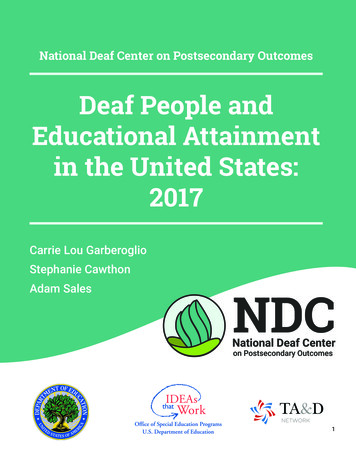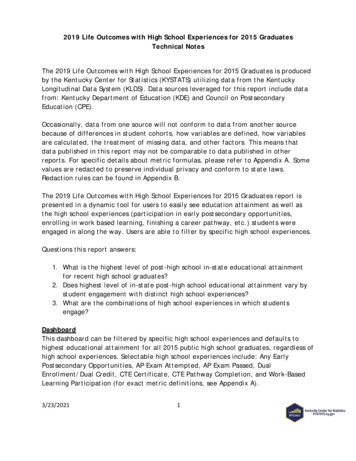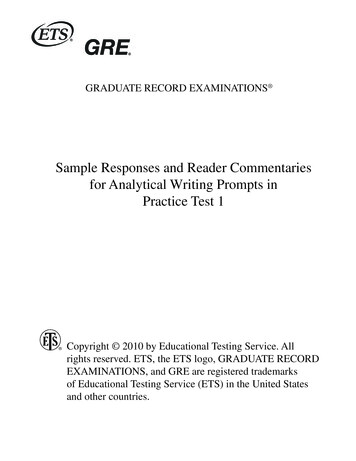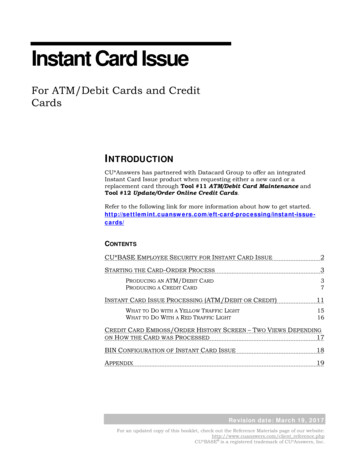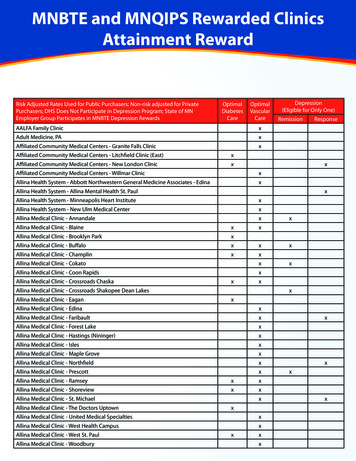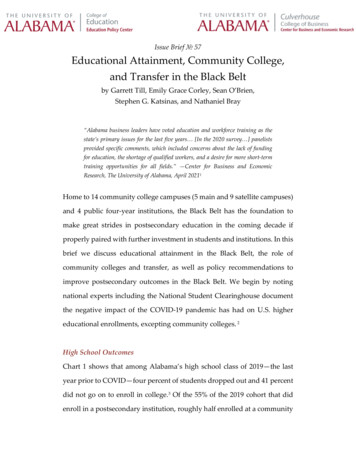
Transcription
Issue Brief 57Educational Attainment, Community College,and Transfer in the Black Beltby Garrett Till, Emily Grace Corley, Sean O’Brien,Stephen G. Katsinas, and Nathaniel Bray“Alabama business leaders have voted education and workforce training as thestate’s primary issues for the last five years [In the 2020 survey ] panelistsprovided specific comments, which included concerns about the lack of fundingfor education, the shortage of qualified workers, and a desire for more short-termtraining opportunities for all fields.” —Center for Business and EconomicResearch, The University of Alabama, April 20211Home to 14 community college campuses (5 main and 9 satellite campuses)and 4 public four-year institutions, the Black Belt has the foundation tomake great strides in postsecondary education in the coming decade ifproperly paired with further investment in students and institutions. In thisbrief we discuss educational attainment in the Black Belt, the role ofcommunity colleges and transfer, as well as policy recommendations toimprove postsecondary outcomes in the Black Belt. We begin by notingnational experts including the National Student Clearinghouse documentthe negative impact of the COVID-19 pandemic has had on U.S. highereducational enrollments, excepting community colleges. 2High School OutcomesChart 1 shows that among Alabama’s high school class of 2019—the lastyear prior to COVID—four percent of students dropped out and 41 percentdid not go on to enroll in college.3 Of the 55% of the 2019 cohort that didenroll in a postsecondary institution, roughly half enrolled at a community
college, and the other half at four-year colleges and universities. Alabamais a long way from achieving outcomes to show community colleges are thedefault from high school.Universal postsecondary access is not as attainable as it should be for largenumbers of Alabama youth, and COVID has made the situation worse.“Stop-outs”—students who graduate high school but do not go on topostsecondary education—increased from 41% in the class of 2019 to 49%in Alabama’s class of 2020.4In the first brief of this Black Belt 2022 issue brief series, COVID-19 andAlabama’s Black Belt, we noted that the pandemic impacted all of ruralAlabama, and the Black Belt even more so. These same trendlines are notsurprisingly found in the data here. Six of the ten Alabama counties withthe highest stop out rates for the class of 2020 were in the Black Belt, where2
the average stop out rate across all 25 Black Belt counties is over 50%. Asthe COVID-19 pandemic drove education online, the number of studentsgoing on to a 2-year college in 2020 increased to 27% statewide. Notsurprisingly, though, given the gaps in broadband access exposed by thepandemic (also documented in EPC’s Black Belt 2020 series), the Black Beltaverage was slightly lower.5 Meanwhile, only 3 of the top 10 counties withthe highest community college-going rate were in the Black Belt. With thestop out and community college-year going rates rising statewide, the 4year going rate decreased from 29% to 24% in 2020. The Black Belt average4-year going rate was lower at 22%; just 2 of 10 counties with the highest 4year going rate are in the Black Belt—Montgomery and Macon, both hometo or nearby to several four-year colleges and universities. All of Alabama’smetro counties were in the top 10 for 4-year going rate except for Mobile.Educational Attainment on a State and National ScaleTo address the 51% of students who pursued higher education in the classof 2020, we now compare the Black Belt to the state and nation. Chart 2displays the highest level of educational attainment for persons over 25 in2019.6 20% of the population of the Black Belt attended but did not completecollege, with just another 7.5% and 10% going on to attain their associate’sand bachelor’s degrees, respectively. While the Black Belt seems to be aheadof the curve by population with high school degrees, and keeps pace withpopulation with some college and associate’s degrees, the Black Belt fallsbehind once bachelor’s degrees and higher are considered.3
The Black Belt is still behind the state and nation in its share of adults overthe age of 25 with some sort of educational attainment, beyond a highschool diploma. Based on the data above, we see a total of 81% of the BlackBelt adults over age 25 having attended and/or graduated from a secondaryor postsecondary institution, leaving 19% of the Black Belt out of thepostsecondary academic market as they did not obtain their high schooldiploma or equivalent or attempt higher education.Associates Degree Attainment Over Time: The Black Belt is Catching UpChart 3 compares the percentage of the U.S., Alabama, and Black Beltpopulation with an associate’s degree over three decennial census periodsgoing back to 2000.7 The Alabama statewide average, well behind thenational average in 2000, had caught up to the nation by 2019, but the BlackBelt average continued to lag. In fact, while both the Black Belt andstatewide averages improved compared to the national averages, the gap4
between the Black Belt and the Alabama statewide average widened, from.7 to 1.0, between 2000 and 2019.The small percentage differences displayed in Chart 3 might be explainedby prior EPC research in 2020 documenting the Black Belt’s decliningoverall population and declining elementary and secondary schoolenrollments: in other words, even as both population and high schoolgraduations decline, more pursue life-changing community collegedegrees. This is an important public policy subject that deserves furtherstudy.8,9That associate’s degrees are steadily increasing in popularity in the BlackBelt likely reflects the policy shift by the Alabama Community CollegeSystem to create comprehensive community colleges in the 1990s, ratherthan single-purpose technical colleges that had limited (if any) generaleducation transfer programs that led to associate’s degrees. We applaudsuccessive leaders of ACCS for their commitment to this policy shift.5
Bachelor’s Degrees inthe Black BeltChart4showsthepercentage of populationwith a bachelor’s degreeor higher for the 25 BlackBeltcounties,Alabamathestatewideaverage, and the nationalaverage for 2019. TheBlack Belt average of 17%byitselfisexplanatory,notbecauseMontgomery County isan outlier, exceeding thestate and national ratesforthislevelofeducational attainment.10Montgomery’shigherthan average bachelor’sdegree attainment reflects its physical proximity to more four-yearinstitutions, both in Montgomery County (Alabama State University, TroyUniversity–Montgomery, Auburn University at Montgomery) and nearbyLee County (Auburn University). This also reflects Montgomery County’slargest employer: state government. Roughly 25% of nonfarm employmentin Montgomery is state or local government, compared to just 16% inBirmingham, and these jobs are more likely to require a bachelor’s degree.116
In contrast to Montgomery (which is in the eastern Black Belt), there are fewfour-year institutions that serve the western Black Belt—the University ofWest Alabama, which is deeply committed to serving the Black Belt, is theonly public four-year college or university in a western Black Belt county.There are also fewer private four-year institutions in the western Black Belt,as several have closed in recent years, including Concordia College (anHBCU in Selma) and Judson College (in Marion). The lack of statesupported student aid could not have helped these institutions reach morehigh school students and adult learners in the sparsely populated westernBlack Belt. This limited the state’s ability to maximize progress made in thecommunity college sector.There are many geographic factors associated with rural persistent povertyareas that limit access to higher education.12 In 2022, for Black Beltcommunities, often geographically isolated with limited financialresources, delivering on the promise of better education and economicopportunities for their young people and young adults are often out ofreach. For nearly 75 years, there have been promises to extend state andfederal roadways through the Black Belt with no action. In 2019, GovernorKay Ivey and the state legislature finally made good on those past promisesto build a four-lane road through the Black Belt with the approval of theRebuild Alabama Act of 2019, while congressional leaders continue ationandinfrastructure (i.e., maintained roads in this instance) are some of thegreatest geographic barriers preventing Black Belt residents from pursuinghigher education. This is why the 2002 statement of Robert Pedersen—that7
in rural America access to higher education in practice means access to areliable used car—still rings true today. 13Community College Enrollment and Pell GrantsAs in Chart 3 shows, there has been growing interest in community collegesin recent years because of their low cost and greater availability. However,in the Black Belt, community college enrollment appears to be lower due tothe higher out-of-pocket expenses (especially child care and transportation)of living in sparsely populated area that spans over 20,000 square milesacross 25 counties (larger than 9 U.S. states by area). 14Chart 5 shows the enrollment of all 5 main community college campuseslocated inside the Black Belt.15 Chattahoochee Valley Community College(CVCC) in Russell, H Council Trenholm State (Trenholm) in Montgomery,and George C Wallace State Community College–Selma (WCCS) each8
enroll about 30% of the students attending Black Belt commuinty collegemain campuses. This is likely due to their proximity to major roadways andcities, as well as their well-respected industrial maintenance, earlyeducation, and nursing programs.A consistent theme running across the Education Policy Center’s 20 studieson Pell Grants is that with state investments in the state student aid at thebottom of the 16 Southern Regional Education Board states (under fivepercent of the total), federal Pell Grants are Alabama’s de facto state studentai program. Alabama students rely on Pell, but congress cut federal Pellgrants five straight years starting in Fiscal Year 2012. 16 Not surprisingly,enrollments fell five straight years, and eventually lower completionsresulted across Alabama. 17 Chart 6 would suggest there is some correlationbetween the share of tuition and fees covered by Pell grants and theenrollment in the Black Belt’s five main community college campuses. 18Prior to the cuts, the average Pell grant covered up to 104% of tuition andfees, with enrollment exceeding 1,200 students at each institution on9
average. After the cuts, Pell in the 2019-2020 school year covered less than80% of tuition and fees, and enrollment has since averaged below 1,000 ateach campus.Community Colleges as Transfer PathwaysIn Fall 2021, 7,618 students across Alabama started their journeys atAlabama community colleges before transferring to four-year institutions.James C. Palmer calls community colleges “the neighborhood schools ofhigher education,” due to their easier, more affordable transition to thecollegiate environment, with smaller classes, more personal attention, andmuch lower cost (roughly half of public university charges).19The Alabama General Studies Committee (AGSC) oversees the StatewideTransfer & Articulation Reporting System (STARS), which oversees a 41course guaranteed acceptance of community college coursework for thestate’s 14 public universities.20 When AGSC&STARS was created in 1994,Alabama was one of five states in the country to have a bottom-up structureto guarantee transfer credit acceptance, with a committee of two- and fouryear professionals to oversee the process. Today AGSC&STARS is housedat Troy University, and we turn to an analysis of STARS Guide usage toconsider Black Belt students’ transfer intent.10
In Fall 2020, the average share of total Full Time Equivalent (FTE) studentsrequesting a STARS Guide across all of Alabama’s community colleges was31%—so, nearly a third of all 2-year students are potentially interested intransferring to a 4-year institution.21 However, for community colleges inthe Black Belt, this is not always the case. At Wallace State CommunityCollege Selma, only 10% of students requested one or more STARS Guides(significantly below the state average), and Chart 7 shows that this amountsto less than 1% of all unique STARS Guide requests compared to nearly 2%of all FTE community college students in Alabama. The last column inChart 7 shows that Wallace State–Selma students are under-representedamong STARS Guide requestees by over 60%. On the otherhand,Chattahoochee Valley and Trenholm State students are over-representedamong STARS Guide requests relative to their total FTE enrollment. In total,students at Black Belt community colleges are over-represented amongSTARS Guide requests compared to non-Black Belt students by about 9%.11
Despite this Black Belt community colleges being slightly over-representedamong STARS Guide requests overall, Chart 8 shows that the statewideaverage transfer-out rate for Black Belt community colleges is much lowerthan for non-Black Belt community colleges. Transfer-out rates refer to thenumber of students transferring out to another community college or fouryear university; the strikingly different patterns mean fewer Black Beltstudents are able to overcome the financial and other barriers to transfer.In addition to STARS Guide requests, the AGSC reports data on 2-yearstudents’ transfer institutions of choice among the state’s 14 publicuniversities, four of which are in the Black Belt (ASU, AUM, TroyMontgomery, and UWA).22 In Fall 2020, enrollment at these fouruniversities comprised about 18% of total public university enrollmentstatewide, however only about 16% of transfer-intending students list oneof those four institutions as their 1st or 2nd choice of transfer institution ontheir STARS Guides. This, combined with lower rates of STARS Guide12
requests at some Black Belt community colleges, may indicate a lower levelof interest among these students in pursuing further education beyond thefirst two years, in that the cost is seen as a bridge too far. We note thatnational experts including longtime former Western Interstate Commissionon Higher Education President James Longendecker advocated for policyalignment across state appropriations, tuition, and state student aidpolicies—something Alabama can never attain with such a small statestudent aid program.With no state student aid program, Black Belt community college studentsface geographic challenges other community college graduates in the statedo not: in the western Black Belt in particular, the act of transfer requiresphysical relocation, for the distances are too far for daily commuting to getto the junior and senior year. While a bachelor’s degree is clearly notrequired to attain a well-paying job, some form of postsecondary educationis, and the more on-ramps to lifelong learning opportunities that candisrupt the cycle of persistent poverty, the better. 23Policy RecommendationsPostsecondary education is increasingly important for Alabama to attractand retain high-wage, high-skill jobs in all sectors, and the more peopleobtaining degrees and certificates, the better. By 2025, it is estimated that60% of people in the state will need a degree or credential beyond a highschool diploma.24 In the Black Belt, a post-secondary degree or credentialcan offer more than a path to a good-paying job. In a region historically andcurrently struggling with high levels of poverty, promoting educationbeyond high school can be a key tool for disrupting and ending the cycle of13
poverty. The overarching recommendation of this brief is to increaseinvestment into post-secondary education in the Black Belt, to help makecommunity colleges the default from the Black Belt’s high schools, and tofacilitate transfer and degree completion at four-year universities andcolleges. There is a large market of potential postsecondary students in theBlack Belt—made up primarily by adults who graduated high school butdid not go on to college—and catering to these students will require carefulalignment of education with well-paying employment opportunities.Building on the recommendations of the previous briefs in this series, whichhave emphasized incentives to draw and retain healthcare workers andteachers to the Black Belt, investment in post-secondary education in theregion should also focus on increasing enrollment in high-demand fields ofhealthcare and teaching, as well as advanced manufacturing, which is agrowing industry in the Black Belt. Such investment should target bothstudents and institutions. Scholarships for students pursing degrees in theidentified high-demand fields would make it more financially feasible forthem to pursue these degrees, and additional student loan forgivenesswould incentivize students to stay and work in the Black Belt for anextended period. Increasing investment at the institutions would alsoincrease the resources available to these high-demand programs to engagein more recruitment efforts, expand course offerings, hire more instructors,and increase resources available to students for things like transfercounseling.Further, this brief has shown a correlation between Pell availability andpost-secondary enrollment.25 Since Alabama has over the past seven14
decades chosen not to make significant investments in state-funded studentaid, the federal Pell Grant is the de facto state student aid program in theBlack Belt. For this reason, it is essential that students are counseled on howto complete the Free Application for Student Aid (FAFSA) to access regularacademic and summer Pell Grants, which the EPC worked to makeavailable nationwide. Last year, Alabama took steps to improve FAFSAcompletion statewide, as the state board of education voted to require highschool seniors complete the FAFSA to graduate high school (thoughstudents can still opt-out with a parental waiver).26 We strongly supportthis initiative, though we note that many Black Belt school superintendentshave expressed concern that impoverished parents are not filing theirfederal tax returns, an essential piece of information for students tocomplete the FAFSA. For this reason, we strongly support pairing theFAFSA high school graduation requirement with increased stateinvestment in counseling targeting at Alabama’s 19 persistent povertycounties, all of which are in the Belt, so that students and parents can getthe help they need to navigate the federal student aid application andcollege process.We also call for a statewide lottery to fund free community college beyondhigh school, to bring hope not only to the Black Belt’s 34,000 rising middleand high school students, but also to young adults statewide. The EPCproposed a plan for Alabama modeled after Tennessee Achieves, thenation’s first statewide promise program, signed into law by formerGovernor Bill Haslam, a Republican, in 2015.27 This was the first statewidePromise program; today twenty-eight other states have Promise programsof some kind. It is time for Alabama to join this national movement.15
Finally, a common route taken by many prospective students (traditionaland non-traditional age) in the time of COVID is online schooling.However, with much of the Black Belt having extremely limited (and insome cases zero) access to high-speed broadband internet, online classes areof a limited value for students from the region.28 This same issue isdiscussed in a previous brief concerning the Black Belt’s STEM education.Broadband expansion in this rural region is necessary to increase the accessand viability of online schooling, which offers a more flexible alternative toin-person learning, particularly in terms of time and transportation.THE EDUCATION POLICY CENTER AT THE UNIVERSITY OF ALABAMAEstablished in 1924, the Education Policy Center is The University of Alabama’s oldest center orinstitute. Through its ongoing nonpartisan research and programs, it seeks to assist the College ofEducation and the University to fulfill their mission to improve the quality of life for allAlabamians. The EPC promotes expanding access and success, strengthening equity, andadvancing economic and community development with special emphasis on telling the story of theDeep South to policymakers in Alabama, the region and nation. In 2020, EPC released the Black Belt2020 issue brief series examining policy issues pertinent to the Alabama Black Belt. Black Belt 2022builds upon this work and will examine new issues as well as revisit previous issues.Director: Stephen G. Katsinas, Ph.D.Associate Director: Nathaniel Bray, Ph.D.Project Coordinators/Managers: Brandi M. Stacey, Michael S. Malley, Jr., & Stephanie PaulSenior Fellow & Issue Briefs Editor: James E. “Ed” Davis, PhD (Emeritus, MS State University)Associate Issue Briefs Editor: Phillip D. Grant, Ph.D. (University of West Georgia)Senior Fellows: Arleene P. Breaux, Ph.D., James E. “Skip” Dotherow, Ph.D., Phillip D. Grant,Ph.D., Ray Huebschmann, Ph.D., Brian K. Johnson, Ph.D., Vincent A. Lacey, Ph.D., R. FrankMensel, Ph.D., David Murphy, Ph.D., J. WarnerFellows: Mark D’Amico, Ph.D., Janice Friedel, Ph.D., Linda Hagedorn, Ph.D., Michael Kennamer,Ph.D., Dustin Smith, Ph.D.Research Associates: Emily Grace Corley, Noel Keeney, Sean O’Brien, & Garrett Till401 Queen City Avenue Box 870249, Tuscaloosa, Alabama 35487 · Telephone: (205) 348-6004 ·http://edpolicy.ua.edu16
THE CENTER FOR BUSINESS AND ECONOMIC RESEARCH ATTHE UNIVERSITY OF ALABAMAThe primary roles of the Center for Business and Economic Research (CBER) are in research andservice to the State and people of Alabama and the nation at large. The Center, established in 1930,is committed to promoting economic development throughout Alabama. CBER’s research spanseconomic and fiscal policy analysis, business, environmental, economic and workforcedevelopment studies. CBER also collects, maintains, analyzes, and releases business andsocioeconomic data. CBER clientele include federal, state, and local government agencies, privatecompanies, other academic institutions, financial institutions, individuals, and the media. As aresource for in-depth studies/analysis/forecasts, CBER provides insight and information with theaim of improving the quality of decision-making by our clientele. CBER is an outreach/researchcenter of the Culverhouse College of Business, one of the leading business schools in the country.Associate Dean for Economic Development & Senior Research Economist: Samuel Addy, Ph.D.Executive Director: Ahmad Ijaz Associate Director of Research & Outreach: Morgan CordleDirector of Socioeconomic Analysis & Demographics: Nyesha Black, Ph.D.Assistant Research Economist: Kilungu Nzaku, Ph.D.Socioeconomic Analyst: Susannah Robichaux Economic Forecaster: Stephanie Normanyo1500 Greensboro Avenue, Suite 1 Box 870221, Tuscaloosa, Alabama 35401 ·Telephone: (205) 348-6191 · https://cber.culverhouse.ua.eduCBER, Staff. “Top Issue Facing Alabama: Education and Workforce Training.” Centerfor Business and Economic Research, August 31, or-alabama/.12National Student Clearinghouse Research Center (2022). Term Enrollment Estimates,Spring 2021.3 Education, Alabama State Department of. 2019. College and Career Readiness - 2018-2019Graduation Rate. Alabama State Department of Education.42022. Term Enrollment Estimates, Spring 2021. Estimates, National Student ClearinghouseResearch Center.5 Stephen G. Katsinas, Noel E. Keeney, Emily Jacobs, Emily Grace Corley, and HunterWhann. 2020. Internet Access Disparities in Alabama & the Black Belt. Brief, Tuscaloosa, AL:The Education Policy Center at the University of Alabama.6 Federal Reserve Economic Data, Education Attainment, Annual. Available athttps://fred.stlouisfed.org/release/tables?rid 330&eid 3914437 Federal Reserve Economic Data, Education Attainment, Annual. Available athttps://fred.stlouisfed.org/release/tables?rid 330&eid 3914438 Katsinas, S.G., Keeney, N.E., Jacobs, E., Whann, H. (Aug. 2020). School Enrollment inAlabama’s Black Belt Continues to Decline. The Education Policy Center at theUniversity of Alabama. Available at http://edpolicy.ua.edu/research/black-belt/17
Katsinas, S.G., Keeney, N.E., Jacobs, E., Whann, H. (Aug. 2020). The Black Belt’sPopulation Decline Explains Why Alabama May Lose a Congressional Seat in the 2020 Census.The Education Policy Center at the University of Alabama. Available athttp://edpolicy.ua.edu/research/black-belt/10 U.S. Census Bureau, American Community Survey, 5-year estimates. Available athttps://data.census.gov/cedsci/table?hidePreview true&tid ACSDP1Y2019.DP0211 U.S. Bureau of Labor Statistics. Economy at a Glance: Montgomery, AL & BirminghamHoover, AL. Retrieved March 8, 2022 fromhttps://www.bls.gov/regions/southeast/al montgomery msa.htm12 Shannon, Mary Lee Rice. 1976. Poverty in Alabama: A Barrier to Postsecondary Education.Study, Tuscaloosa, AL: The University of Alabama: Institute of Higher EducationResearch and Services.13Katsinas, Opp, and Alexander, “Preserving Access with Excellence: Financing RuralCommunity Colleges, 2003 issue brief for the Rural Community College Initiative.14Bureau, U.S. Census. 2021. State Area Measurements and Internal Point Coordinates.Census Report, U.S. Census Bureau.15 Integrated Postsecondary Education Data System accessed by the Education PolicyCenter at the University of Alabama on February 23, 2021916Stephen G. Katsinas, Nathaniel J. Bray, Noel E. Keeney, Hunter D. Whann, AndMichael S. Malley, Jr. 2020. Keeping the Promise: Stabilizing the Pell Grant Program. PolicyBrief, College Promise.17 Stephen G. Katsinas, Nathaniel J. Bray, Jonathan P. Koh, and Phillip D. Grant. 2012. AStudy of Pell Grants in Alabama. Study, Tuscaloosa: Education Policy Center at theUniversity of Alabama.18 Integrated Postsecondary Education Data System accessed by the Education PolicyCenter at the University of Alabama on February 23, 202119 Alabama Community College System. 2-to-4 Transfer. ACCS. Retrieved February 27,2022 from https://www.accs.edu/academics/2-to-4-transfer/.20 AGSC & STARS. History and Background. AGSC & STARS. Retrieved February 27, 2022from http://stars.troy.edu/history background.html.21 AGSC & STARS. Two Year Student Usage Report by Institution July 2020 to June 2021.AGSC & STARS. Retrieved February 27, 2022 fromhttp://stars.troy.edu/ura 2020 2021/annual-2yr-institution.htm.22 AGSC & STARS. Transfer Institution Choices by Two-Year Students. AGSC & STARS.Retrieved February 27, 2022 from http://stars.troy.edu/ura 2020 2021/annual-2yrchoice.htm.23Bureau, U.S. Census. 2019. Poverty Status In The Past 12 Months Of Individuals ByEducational Attainment. Accessed March 2022.https://data.census.gov/cedsci/table?q C17003&tid ACSDT1Y2019.C17003&hidePreview false.24 Lumina Foundation. (2021, February). A Stronger Nation: Learning beyond high schoolbuilds America’s talent: Alabama’s Report ion/report/2020/#state/AL&stsid byAttainment&s-tsrvs 118
25Stephen G. Katsinas, Nathaniel J. Bray, Jonathan P. Koh, and Phillip D. Grant. 2012. AStudy of Pell Grants in Alabama. Study, Tuscaloosa: Education Policy Center at theUniversity of Alabama.26 Crain, T.P. (2021, April 8). Alabama becomes fourth state to require FAFSA to graduate highschool. Al.com. .html.27 Bowen, J.R., & Corley, E.G. (2020, December 16). A Lottery-Funded Alabama CollegePromise & Alabama Opportunity Scholarship. The Education Policy Center at the Universityof Alabama. 201214 AlabamaCollege-Promise.pdf28 Ibid, 5.19
Montgomery's higher than average bachelor's degree attainment reflects its physical proximity to more four-year institutions, both in Montgomery County (Alabama State University, Troy University-Montgomery, Auburn University at Montgomery) and nearby Lee County (Auburn University). This also reflects Montgomery County's
